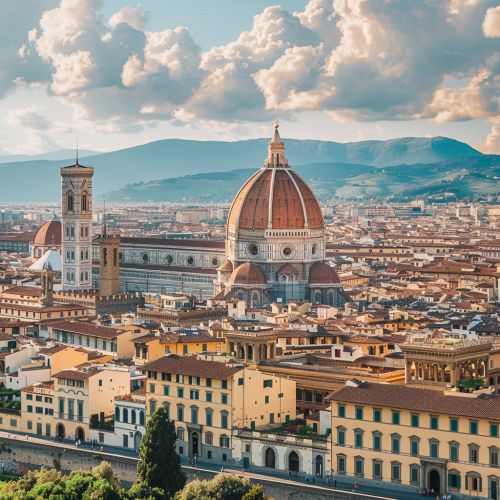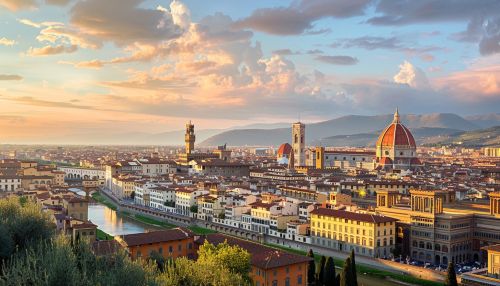Florence
History
Florence, known as Firenze in Italian, is a city with a rich and complex history. The city's origins can be traced back to 59 BC, when it was founded by Julius Caesar as a settlement for his veteran soldiers. Throughout the centuries, Florence has been a Roman city, a bustling medieval commune, and a cultural and artistic epicenter during the Italian Renaissance.
The city's historical significance is evident in its architecture, from the Romanesque buildings of the Middle Ages to the Gothic structures of the 13th century, and the Renaissance masterpieces of the 15th and 16th centuries. The city's historical center, a UNESCO World Heritage site, is a testament to the city's historical and cultural significance.


Geography
Florence is located in the central region of Italy, in the heart of Tuscany. It is surrounded by rolling hills that are home to vineyards and olive groves. The city is bisected by the Arno River, with the historical city center located on the north bank of the river. The city's geographical location has played a significant role in its history and development, providing a natural defense system during the Middle Ages and influencing the city's unique architectural style.
Architecture
Florence is renowned for its architecture, which spans several centuries and styles. The city's architectural landmarks include the Duomo, the Ponte Vecchio, and the Palazzo Vecchio. These structures, along with many others, have contributed to the city's reputation as one of the world's most architecturally significant cities.
The Duomo, or the Cathedral of Santa Maria del Fiore, is one of the most iconic structures in Florence. Its massive dome, designed by Filippo Brunelleschi, is considered a masterpiece of Renaissance architecture. The Ponte Vecchio, a medieval stone bridge spanning the Arno River, is notable for the shops that are built along it, a common practice in medieval cities. The Palazzo Vecchio, the town hall of Florence, is a massive, Romanesque fortress-palace that is one of the most impressive town halls in Tuscany.
Art
Florence is often referred to as the "Cradle of the Renaissance" for its pivotal role in the cultural and artistic movement. The city is home to some of the world's most famous museums and galleries, including the Uffizi Gallery and the Accademia Gallery, which house works by masters such as Michelangelo, Leonardo da Vinci, and Botticelli.
The city's rich artistic heritage is not confined to its museums and galleries, however. Many of Florence's public spaces and churches are adorned with works of art, including frescoes, sculptures, and architectural details. This integration of art into the fabric of the city is a defining characteristic of Florence and a testament to the city's historical and ongoing commitment to the arts.
Economy
Florence's economy is diverse and robust, with key sectors including tourism, manufacturing, and services. The city is known for its high-quality craftsmanship, particularly in the fields of leather goods and fashion. Florence is home to several renowned fashion houses, including Gucci and Salvatore Ferragamo, which contribute significantly to the city's economy.
Tourism is another major economic driver in Florence, with millions of visitors each year drawn to the city's historical sites, museums, and cultural events. The city's rich history, combined with its contemporary attractions, make it a popular destination for both domestic and international tourists.
